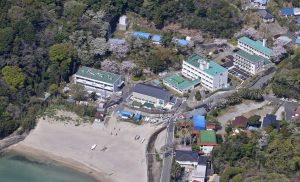The Center was founded in 1933 as a marine station of Tokyo University of Literature and Science, being renamed to the Tokyo University of Education Shimoda Marine Research Facility in 1949. With the creation of University of Tsukuba in 1976, it then became the Shimoda Marine Research Center (SMRC), and was positioned as a Joint-Use/Research Institute within the university. In 2010, it was reorganized as a Nationwide Joint-Use/Research Institute, with nearly 8,000 visiting researchers and students annually. There are three research buildings, biological culture facilities, training facilities, an ocean observation building, and dormitories accommodating up to 85 people. SMRC possesses four research vessels, with the largest being Tsukuba II (19t, 40-person capacity). Since its establishment, a wide range of biological research has been conducted at SMRC, including phylogenic studies of horseshoe crabs, allorecognition in colonial ascidians, and physiological and ecological studies of marine algae. Currently, the subject areas of active research in the Center include cellular biology (using various marine invertebrates such as sea squirts and sea urchins), developmental biology, evolutionary biology, marine ecology, and marine environmental biology. In 2016, a research station for studying the effects of ocean acidification was established on Shikine-jima, Izu Islands.

Address: 5-10-1, Shimoda, Shizuoka 415-0025, Japan E-mail: jambio@shimoda.tsukuba.ac.jp HP: http://www.shimoda.tsukuba.ac.jp/eng-home.html
